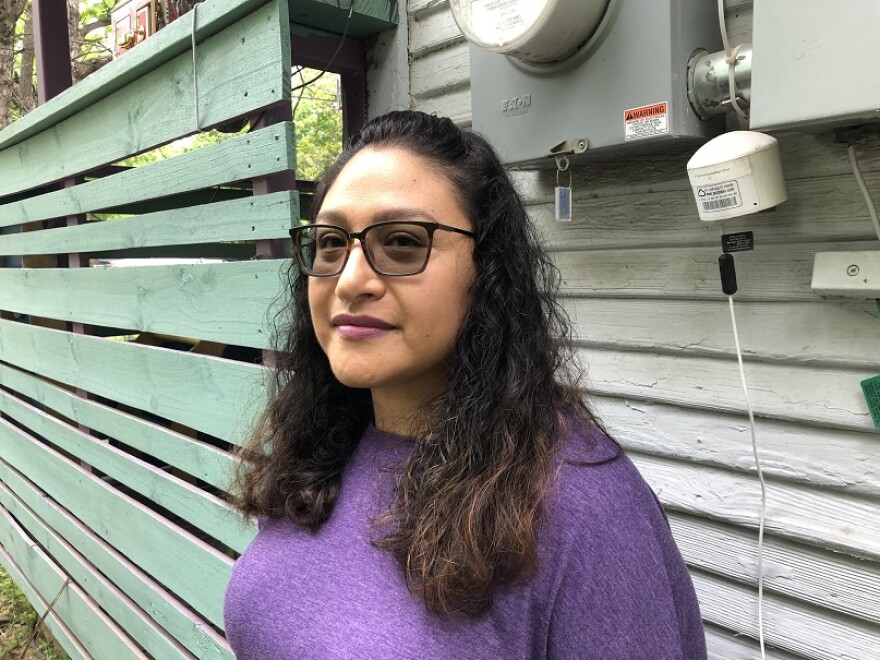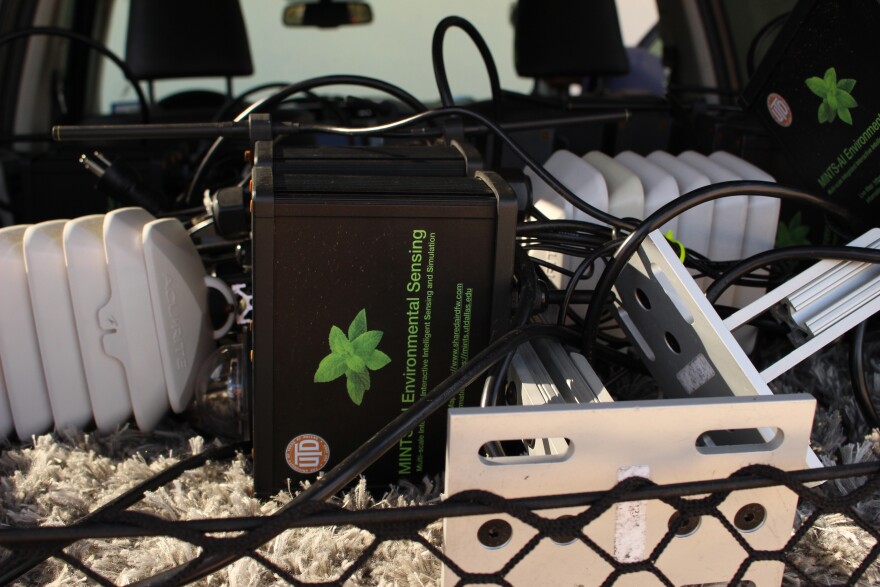Janie Cisneros has led a campaign the past few years to get the asphalt shingle company GAF to leave her Singleton neighborhood in West Dallas. And it all started with a sensor.
“This was the catalyst for everything,” Cisneros said, gesturing to a small, white cylinder hanging next to the electricity meter outside her home.
A researcher contacted Cisneros in 2020 to ask if she had reliable Wi-Fi and if she’d be willing to host a sensor. About a year later, he sent her the statistics of what it detected.
It wasn’t good. Cisneros said the readings for particulate matter were above both national and international regulatory standards. In West Dallas, the data led to concern over air pollution, which then led to GAF agreeing to leave. (The company has set a date of 2029. Cisneros and others are fighting for an earlier exit.)
“Once you know what’s happening and what this device is collecting and what it’s telling you and the implications of that, then you know,” she said. “Immediately I wanted to take action.”

The quality of the air in the Dallas-Fort Worth area is not where most residents and local officials want it to be, and people like Cisneros are hungry for more information. They want to know if it's risky to go outside on any given day, especially if they have asthma or other respiratory issues. And having data is vital to demonstrate if their neighborhood already has more than its share of industrial pollution.
There are dozens of Purple Air monitors in the region, the same brand Cisneros had mounted on her house. And a coalition of activists, academics, and local governments have been building their own network of low-cost sensors, along with a dashboard to see the readings in real time.

Yet the coalition is missing a key collaborator in the City of Dallas, which is relaunching its own air monitoring program. The city has yet to decide on how exactly its data will be used, and says it wants to work collaboratively with residents and environmental groups as it installs new sensors this year.
Activists hope the city will make its data available quickly and embed it in decisions about zoning.
“What I’m afraid of is that they’ll have data and will not act on it,” said Jim Schermbeck of the environmental group Downwinders at Risk.
DFW’s air
Several recent developments have raised awareness about the need to address DFW air quality.
- The American Lung Assocation ranked DFW 16th out of 226 metro areas for high ozone and in the bottom quarter for particulate matter in last year’s State of the Air report. The 2023 report is expected soon.
- The federal Environmental Protection Agency recently downgraded the region’s ozone status.
- Regarding particulate matter, the region may be out of compliance if new proposed standards become final, and even those standards are too lenient for health experts, according to the Texas Tribune.
- A 2020 report from Paul Quinn College found a “disproportionate amount of air pollution” emitted in areas with more people of color, like West Dallas and the city’s Southern Sector.
There are health consequences to bad air. In their periodic assessment of the county’s health, Parkland and Dallas County found pediatric asthma much more common in the Southern Sector and West Dallas.
“75212 is the most polluted zip code in the City of Dallas,” Cisneros said. “Our lifespan is much shorter than your average Dallas person.”
Making sense
This is the reason why monitoring the air — and doing something about it — is so important to residents and activists.
The EPA’s monitors are considered the gold standard, but that agency has less than ten air monitors for particulate matter in all North Texas. A state map of monitors shows more that detect ozone.
Schermbeck said communities of color have had to fight to get monitors. He pointed to the Joppa neighborhood of Dallas, where residents defeated a proposal for two new concrete batch plants in 2018 - in part by using handheld sensors that found higher levels of toxins than what the city and industry had claimed.
“Everybody knew they were getting crapped on by industry already and they didn’t want these other two things in, but they didn’t have any way to prove it,” said Schermbeck.
He said after the proposed batch plants were defeated, the city rejected a request from Joppa residents for monitors. That led to the neighborhood becoming a priority location for the SharedAir sensors.
The SharedAirDFW map has different layers where people can view particulate matter readings. It includes data from PurpleAir monitors, popularized during the California wildfires of 2020. The SharedAir partners also have their own low-cost devices, made at the University of Texas at Dallas. EPA monitors are also on the map, as are wind direction and the location of major polluters.

While the EPA data is the most trusted, it’s an hourly average that is a few hours old. The SharedAir and PurpleAir monitors, while less sophisticated, aim to give people real-time readings. That way they can decide whether or not to do certain activities outside, like exercise or walk their kids to school.
“This is sort of the next step to getting to that hyperlocal information that you might need,” said Brandon Morton, the director of economic development for Dallas College.
The SharedAir sensors cost $2,000 to $4,000 to make and the project has between 70 and 100 in the works.
Lakitha Omal Harindha Wijeratne, a research scientist at UTD, said the more sensors in the network, the more useful and reliable the information will be.
“We are always willing to give more sensors. If we have the time and if the resources are there, we’ll do it,” Wijeratne said.
What the SharedAir map doesn’t have, at least right now, is data from the City of Dallas’ recently installed air monitors. The city has at least five up and running, three more in hand, and another 16 purchased. A total of 40 are planned by the end of the year.
The city’s view
Dallas' top environmental official, Carlos Evans, said the city expects its own air quality dashboard will be ready for public view in about a month.
Data from the city’s sensors will first go to a server in the United Kingdom, where the manufacturer — AQ Mesh — will process it and review it for quality. The city can then download it.
Kevin Overton, the city’s air quality manager, said the city will generally get the data about two hours after the company collects it, a speed he called “fairly remarkable.”
Evans, however, said they haven’t decided how quickly to then display the data on a city dashboard.
As for allowing city data to be displayed on the SharedAirDFW map alongside readings from other sensors, Evans said he wants to make sure city councilmembers and the public know what the data can be used for.
“If we go that route, then we’re just going to have to be clear about what they’re reading,” he said.
Evans is going to wait to have a conversation with the SharedAirDFW partners about their data until a summit this summer.
“It makes more sense to us to have that conversation once we get our program up and running,” Evans said. “So that we have data in front of us to be able to speak to what we actually have versus having that conversation in theory about our own program.”
Dallas County government, charged with public health responsibilities, is part of SharedAirDFW. So is Dallas College, the City of Plano, Paul Quinn College, Downwinders, and UTD.
County Commissioner Theresa Daniel said she will continue to talk to the city about participating, but if it chooses not to share its data, “then we’ll cover the whole county.”
“Of course, I want to have as much as we can so it’s as strong of a tool for everybody,” Daniel said. “If I ruled the world, it’d be different.”

From data to action
The City of Dallas had a past incarnation of the Breathe Easy program and never made the data public — hence Shermbeck’s worry that the current program won’t result in concrete action.
"The findings were important in clarifying the benefits of launching a larger local air monitoring program and how to operate the program, (e.g. conduct calibration on sensors before deployment)," Evans wrote in an email.
As the city’s new monitors go up, activists have asked how that data will be used in zoning and permitting decisions.
In a recent virtual public meeting about the development of the city’s comprehensive land use plan, officials did not say if they want to set a benchmark for particulate matter, only that they will use the data to prioritize certain cases.
“We can layer that information onto our planning efforts to help bolster those recommendations and the priorities that we have for certain areas,” said Andrea Gilles from the city’s planning and urban design department.
Evans, in an interview with KERA, would not describe his preferred outcome for how the data would be used.
“My preferred outcome is to produce data that our councilmembers can use and our sister departments can use in implementing programs,” he said.
For her part, Janie Cisneros has another idea about how the city could use its new air data.
When the air smells bad, Cisneros typically files a report with 311, the city’s complaint service. She includes screenshots of the readings from the PurpleAir sensor attached to her house, although she said the ensuing investigation never comments on that data.
The city now has two AQ Mesh sensors near the GAF plant under the new incarnation of the Breathe Easy program. And Cisneros asked the city: would screenshots of readings from city-purchased air monitors factor into investigations from now on?
“And they hadn’t thought about that at that point, but they just said, ‘oh we’ll think about it,’” she said. “But I mean, why not? Why wouldn’t you use that as a factor into your investigation and put that into your process? It’s a data point.”
Asked about that specific idea, Evans emailed that data from new sensors can't be used for the enforcement of regulations but "can help target future inspections ... which will ultimately develop their own evidence."
Editor's note: This story has been corrected. It was 2020, not 2019, when the PurpleAir sensor was installed on Janie Cisneros' house.
Got a tip? Email Bret Jaspers at bjaspers@kera.org. You can follow Bret on Twitter @bretjaspers.
KERA News is made possible through the generosity of our members. If you find this reporting valuable, consider making a tax-deductible gift today. Thank you.







